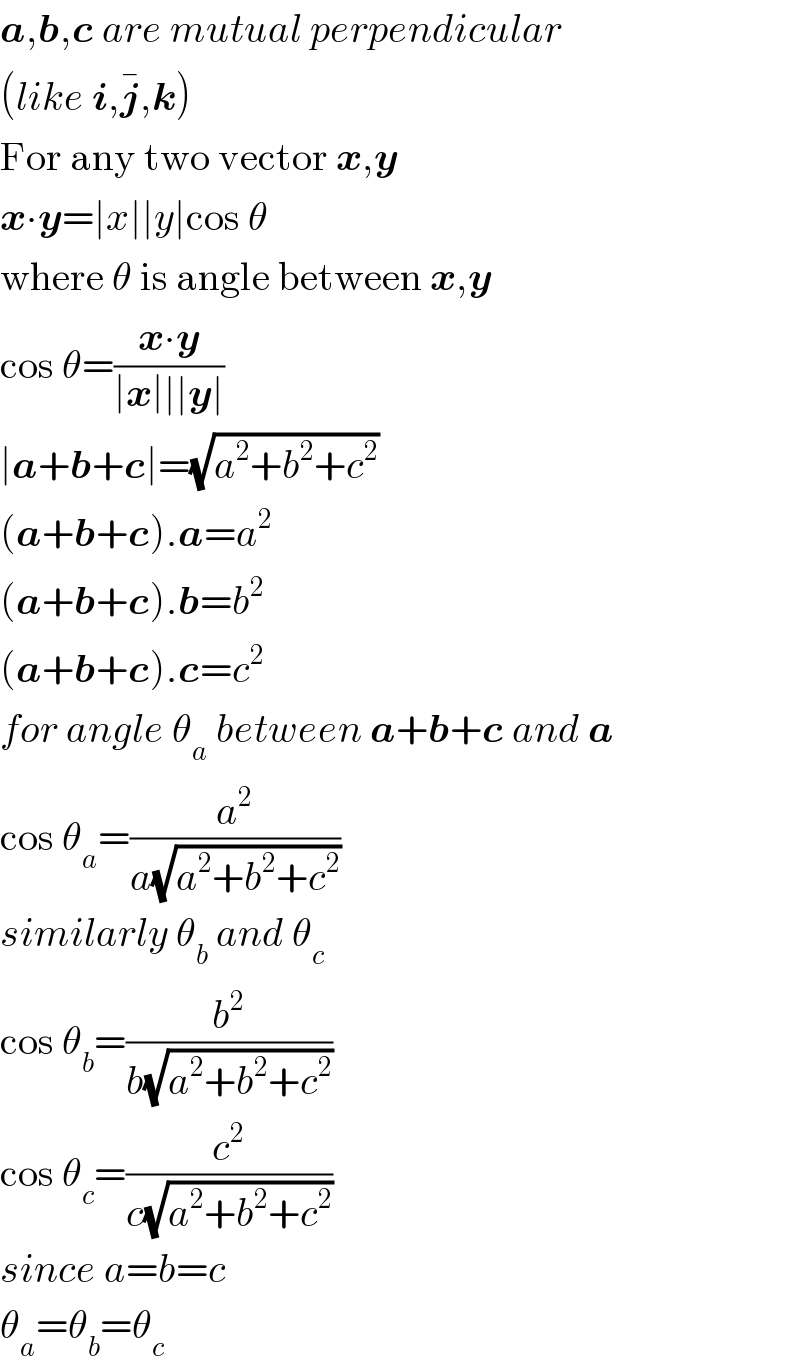
Question Number 15358 by Tinkutara last updated on 09/Jun/17

$$\mathrm{If}\:\overset{\rightarrow} {{a}},\:\overset{\rightarrow} {{b}},\:\overset{\rightarrow} {{c}}\:\mathrm{are}\:\mathrm{mutually}\:\mathrm{perpendicular} \\ $$$$\mathrm{vectors}\:\mathrm{of}\:\mathrm{equal}\:\mathrm{magnitudes},\:\mathrm{show}\:\mathrm{that} \\ $$$$\mathrm{the}\:\mathrm{vector}\:\overset{\rightarrow} {{a}}\:+\:\overset{\rightarrow} {{b}}\:+\:\overset{\rightarrow} {{c}}\:\mathrm{is}\:\mathrm{equally}\:\mathrm{inclined} \\ $$$$\mathrm{to}\:\overset{\rightarrow} {{a}},\:\overset{\rightarrow} {{b}}\:\mathrm{and}\:\overset{\rightarrow} {{c}}\:. \\ $$
Answered by prakash jain last updated on 09/Jun/17

$$\boldsymbol{{a}},\boldsymbol{{b}},\boldsymbol{{c}}\:{are}\:{mutual}\:{perpendicular} \\ $$$$\left({like}\:\boldsymbol{{i}},\bar {\boldsymbol{{j}}},\boldsymbol{{k}}\right) \\ $$$$\mathrm{For}\:\mathrm{any}\:\mathrm{two}\:\mathrm{vector}\:\boldsymbol{{x}},\boldsymbol{{y}} \\ $$$$\boldsymbol{{x}}\centerdot\boldsymbol{{y}}=\mid{x}\mid\mid{y}\mid\mathrm{cos}\:\theta \\ $$$$\mathrm{where}\:\theta\:\mathrm{is}\:\mathrm{angle}\:\mathrm{between}\:\boldsymbol{{x}},\boldsymbol{{y}} \\ $$$$\mathrm{cos}\:\theta=\frac{\boldsymbol{{x}}\centerdot\boldsymbol{{y}}}{\mid\boldsymbol{{x}}\mid\mid\mid\boldsymbol{{y}}\mid} \\ $$$$\mid\boldsymbol{{a}}+\boldsymbol{{b}}+\boldsymbol{{c}}\mid=\sqrt{{a}^{\mathrm{2}} +{b}^{\mathrm{2}} +{c}^{\mathrm{2}} } \\ $$$$\left(\boldsymbol{{a}}+\boldsymbol{{b}}+\boldsymbol{{c}}\right).\boldsymbol{{a}}={a}^{\mathrm{2}} \\ $$$$\left(\boldsymbol{{a}}+\boldsymbol{{b}}+\boldsymbol{{c}}\right).\boldsymbol{{b}}={b}^{\mathrm{2}} \\ $$$$\left(\boldsymbol{{a}}+\boldsymbol{{b}}+\boldsymbol{{c}}\right).\boldsymbol{{c}}={c}^{\mathrm{2}} \\ $$$${for}\:{angle}\:\theta_{{a}} \:{between}\:\boldsymbol{{a}}+\boldsymbol{{b}}+\boldsymbol{{c}}\:{and}\:\boldsymbol{{a}} \\ $$$$\mathrm{cos}\:\theta_{{a}} =\frac{{a}^{\mathrm{2}} }{{a}\sqrt{{a}^{\mathrm{2}} +{b}^{\mathrm{2}} +{c}^{\mathrm{2}} }} \\ $$$${similarly}\:\theta_{{b}} \:{and}\:\theta_{{c}} \\ $$$$\mathrm{cos}\:\theta_{{b}} =\frac{{b}^{\mathrm{2}} }{{b}\sqrt{{a}^{\mathrm{2}} +{b}^{\mathrm{2}} +{c}^{\mathrm{2}} }} \\ $$$$\mathrm{cos}\:\theta_{{c}} =\frac{{c}^{\mathrm{2}} }{{c}\sqrt{{a}^{\mathrm{2}} +{b}^{\mathrm{2}} +{c}^{\mathrm{2}} }} \\ $$$${since}\:{a}={b}={c} \\ $$$$\theta_{{a}} =\theta_{{b}} =\theta_{{c}} \\ $$
Commented by Tinkutara last updated on 10/Jun/17

$$\mathrm{Thanks}\:\mathrm{Sir}! \\ $$
